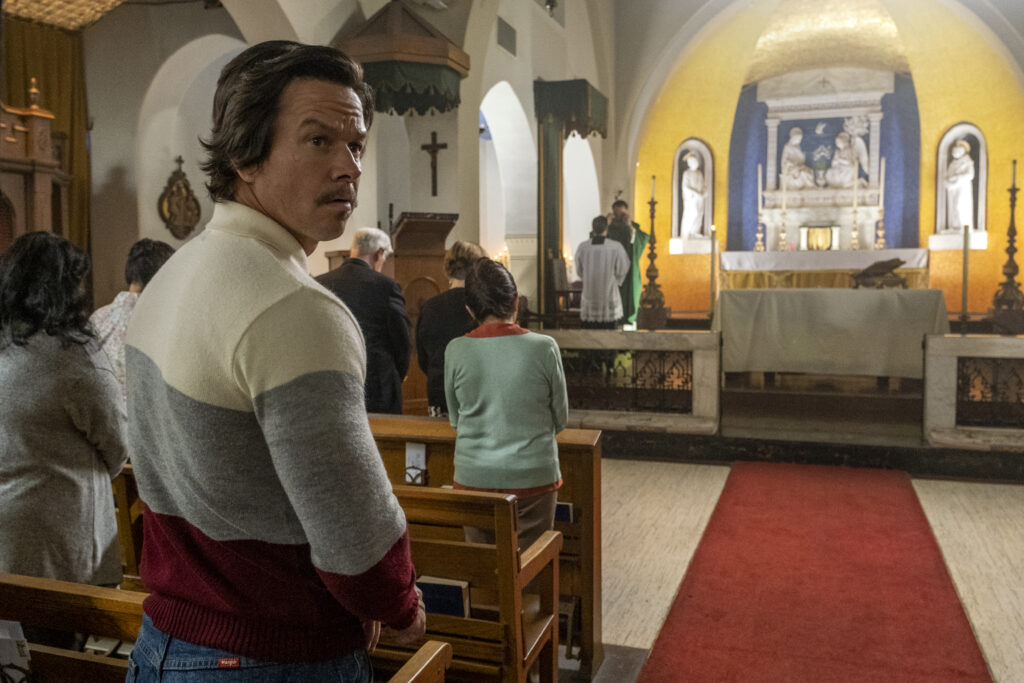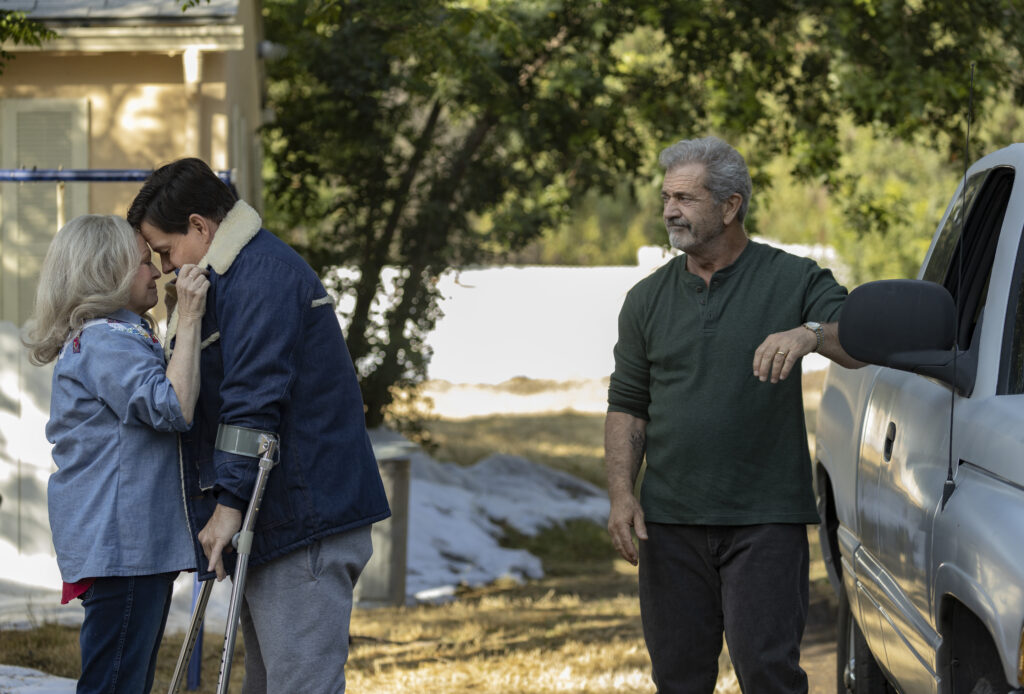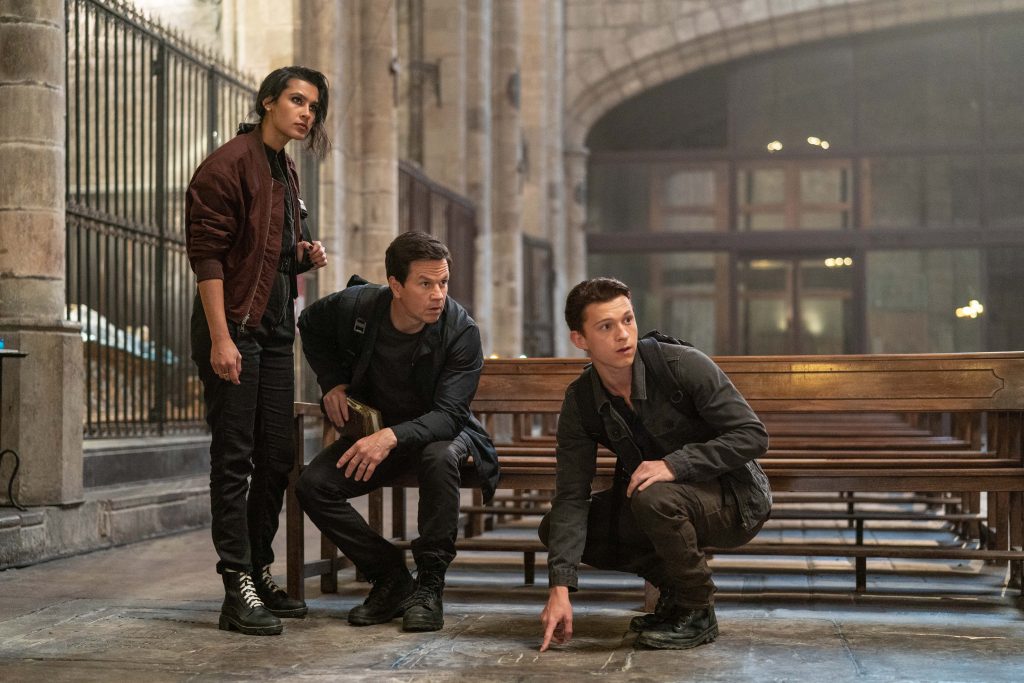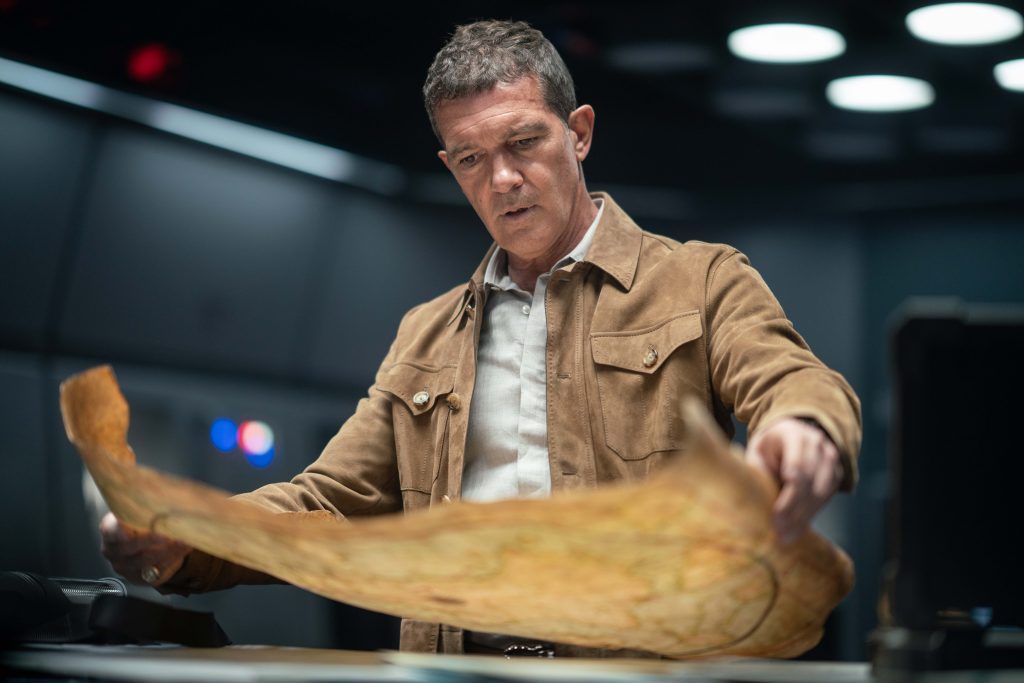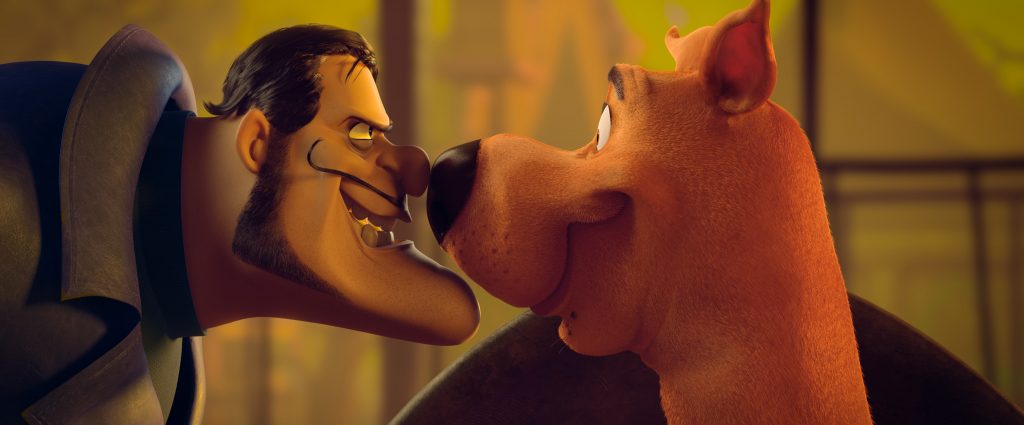March 17, 2024
by Carla Hay

Directed by Simon Cellan Jones
Some language in Spanish with subtitles
Culture Representation: Taking place mostly in 2018, in the Dominican Republic and briefly in the United States, the dramatic film “Arthur the King” (based on the non-fiction book “Arthur: The Dog Who Crossed the Jungle to Find a Home”) features a racially diverse cast of characters (white, Latin, black and Asian) representing the working-class, middle-class and wealthy.
Culture Clash: In 2018, American adventure racer Michael Light comes out of retirement to race with a team in the Adventure Racing World Championship, taking place in the Dominican Republic, and the team has a stray dog who follows them and becomes an unexpected companion.
Culture Audience: “Arthur the King” will appeal primarily to people who are fans of star Mark Wahlberg and true stories about athletic races and dogs who make a impact on people’s lives.

“Arthur the King” is exactly what it appears to be: an unapologetically sentimental drama about a team learning to work together during a grueling adventure race and the stray dog who becomes the team’s unexpected companion. A movie like “Arthur the King” doesn’t have to be award-worthy to be effective for its intended audience. Although certain things in this movie are completely predictable, what will probably affect viewers the most is knowing that it’s based on a true story. Some parts of the movie were changed to make this a Hollywood version of the story, but the outcome in the movie is true to what happened in real life.
Directed by Simon Cellan Jones and written by Michael Brandt, “Arthur the King” is based on Mikael Lindnord’s 2016 non-fiction book “Arthur: The Dog Who Crossed the Jungle to Find a Home.” The title of this book should tell you that this dog has an extraordinary story. However, the namesake of “Arthur the King” (a terrier mix dog named Arthur) doesn’t get a real storyline until about 50 minutes into this 107-minute movie. Some viewers might be irritated that the movie takes this long to prominently feature the dog in the story.
In real life, Arthur was a stray dog who followed Lindnord (who is Swedish) and his team, as they were competing during the 2014 Adventure Racing World Championship in Ecuador. The dog was sick and injured from abuse because of his rough life on the streets of Ecuador. But remarkably, Arthur trekked across 435 miles over 10 days, in various rugged terrains, to be the team’s companion.
In “Arthur the King,” the film’s main human character was changed to be an American named Michael Light (played by Mark Wahlberg), a professional adventure racer, who meets Arthur while Michael leads a team competing in the 2018 Adventure Racing World Championship in the Dominican Republic. “Arthur the King” was filmed on location in the Dominican Republic. Lindnord was in his late 30s when he met Arthur. Wahlberg was in his early 50s when he made this movie, and he looks his age in his face, although Wahlberg’s younger-looking athletic physique in the movie is not typical of men in their 50s.
The Adventure Racing World Championship is a grueling competition that involves navigation, all-terrain cycling, mountain biking, rope work, climbing, trekking, night running and kayaking. The race is open to adults of all genders and has cash prizes that can range from five figures to low six figures. Teams can choose their own paths and strategies in competing in each stage of the race.
“Arthur the King” begins by showing Michael and his team competing in the 2015 Adventure Racing World Championship in Costa Rica. Michael has done this race several times, but he has never been on a team that came in first place. And it will be no different in 2015. Michael is very hotheaded and stubborn (in other words, a typical character portrayed by Wahlberg), and he doesn’t listen to advice from his equally arrogant team member Leo Sun (played Simu Liu) on which path to take. It’s one of many clashes that Michael and Leo have when they work together.
As a result of Michael’s decision, the team gets stuck in a mud bank and doesn’t even place in the top three in the race. Leo takes a photo of a defeated-looking Michael stuck in the mud during this distrastrous experience. Leo is an avid social media user, so he posts this photo on his Instagram account as a way to shame Michael. The photo goes viral, much to Michael’s embarrassment, although Michael is too proud to admit to most people that he’s embarrassed.
The movie then fast-forwards to 2018. The dog who will be named Arthur is briefly shown living on the streets of Santo Domingo, the capital of the Dominican Republic. The movie mentions later that this dog had several injuries from abuse, but fortunately for animal fans, none of this abuse is shown in graphic details in the movie. The dog is seen being shooed away by some people on the streets as the dog looks for food.
In real-life, the dog who portrays Arthur in the movie is named Ukai, who was found at an animal shelter. Ukai had two stunt doubles named Beau and Hunter, but Ukai “performed 90% of the scenes himself,” according the “Arthur the King” production notes. Ukai’s lead trainer is Mathilde De Cagny, who works with Birds and Animals Unlimited in Los Angeles.
Meanwhile, in the fictional city of High Springs, Colorado, a brooding Michael is shown moping in his home about how he didn’t come in first place the 2015 Adventure Racing World Championship. After that race, Michael decided to quit being a professional adventure racer to help raise his daughter Ruby (played by Cece Valentina) with his wife Helen (played by Juliet Rylance), another former professional racer who retired to focus on raising a family. Ruby is about 4 or 5 years old in the movie.
As much as Michael loves his family, several things are bothering him. First and foremost, Michael still has the urge to achieve his goal of coming in first place at the Adventure Racing World Championship. Second, he wants to redeem himself from his humiliating loss in the race in 2015. After nearly 20 years of being a professional adventure racer, Michael says to Helen, as he looks at the “stuck in the mud” photo: “This is not the end for me.” And third, Michael wants to gain back the respect of his father Charlie Light (played by Paul Guilfoyle), who has gotten fed up with Michael being an unemployed grouch.
Helen has also gotten tired of hearing Michael’s whining. She’s loving and supportive when she tells him that if he really wants to compete in the Adventure Racing World Championship again, he should do it and find sponsors. That’s all Michael needs to hear to get back in the racing game again.
Michael first travels to Big Sur, California, to reconnect with his former teammate William “Chik” Chikerotis (played by Ali Suliman), whose best team racing skills are in navigating. Chik has a knee injury that prompted him to retire from adventure racing. When Michael finds Chik, after not seeing each other since 2015, Chik is operating a camping business whose clients are mostly spoiled urban dwellers. Michael can see that Chik isn’t happy in this job, so it doesn’t take much to convince Chik to be on Michael’s resurrected team, although Chik is somewhat skeptical that Michael can get sponsors.
Next on Michael’s list in assembling his “dream team” is expert climber Olivia Baker (played by Nathalie Emmanuel), the daughter of a famous climber named Hugo Baker (played by Oscar Best), who is Olivia’s coach. Michael goes to Oahu, Hawaii, to ask Olivia to be on his team. Olivia needs a lot more coaxing because she doesn’t want to go back to adventure racing. She changes her mind and later reveals the very poignant reason why she decided to be on Michael’s team.
Michael then has a business meeting with a fictional corporate company named Broadrail that Michael has worked with in the past as a sponsor. In this meeting, the executives in the group listen to Michael’s pitch, fully aware that Michael has never won the Adventure Racing World Championship. The biggest skeptic in this corporate group is a smirking executive named Tucker (played by “Arthur the King” producer Tucker Tooley, in an uncredited cameo), who questions if middle-aged Michael and knee-injured Chik can handle the athletic challenges. Decker also wants Michael’s former teammate Leo to be on Michael’s team again, because Leo has a few million followers on social media.
Michael’s biggest supporter in the group is an earnest executive named John (played by Alani Ilongwe), who tries to smooth things over when Michael inevitably gets riled up and has a temper tantrum in response to Decker’s naysaying attitude. Michael also dislikes the idea of working with Leo again. Michael asks for $100,000 in sponsorship money. In the end, Michael has to settle for an offer of $50,000, on the condition that Leo is a member of the team.
Michael then travels to West Hollywood, California, where he finds Leo at a photo shoot, because Leo is now a well-known social media influencer. Michael has some disdain for social media, but he understands why the sponsor wants Leo on the team. Michael has to swallow his pride and admit (at Leo’s insistence) that Michael made a mistake in not listening to Leo’s advice in the 2015 Adventure Racing World Championship. Michael also says that if Leo is on the team, Michael will take Leo’s opinions into account, but Michael as the leader will still make the final decisions.
With this team of four confirmed, they call themselves Team Broadrail and go to the Dominican Republic to prepare for the race. Unrealistically, they only have five days to get accustomed to the environment where they will be racing. The excuse is that they didn’t have the money to travel to the Dominican Republic earlier to fully prepare in the way that they wanted. It’s just the movie’s way of making Team Broadrail look more like underdog. It’s mentioned multiple times that the race will take place in sweltering humidity.
Every sports movie has a main rival that the “hero” wants to defeat. In “Arthur the King,” that team is Team Arc’teryx, led by a cocky Australian named Decker (played by Rob Collins), who likes to taunt Team Broadrail with snide remarks, any chance that he gets. You can easily predict which two teams will be close to the finish line in a climactic scene. Still, each stage of the race has its share of suspense. TV personality Bear Grylls has a cameo as himself in the movie.
As for the story of Arthur, he doesn’t endear himself to the team right away. At first, Michael just sees Arthur as a mangy stray dog that he feeds sausage scraps to when he first sees the dog at a transition area in the race. The members of Team Broadrail don’t see this dog until a few hundred miles later. They are amazed that he was able to follow them and continues to follow them. (This isn’t spoiler information, since it’s in the movie’s trailer.)
Michael names the dog Arthur, after King Arthur. This mutt isn’t just a travel companion. Arthur’s keen senses help Team Broadrail get out of some dangerous situations. And he obviously has a great sense of direction. The performances by the principal cast members (including the dog) are very realistic, even if you know some scenes were fabricated for the movie. The bickering between Michael and Leo adds to the realism. The movie’s action scenes are competently filmed and acted.
The best parts of “Arthur the King” are in the last third of the movie. There’s a life-or-death situation that is meant to be both tearjearking and heartwarming. “Arthur the King” is not subtle at all in its message about how life’s disappointments can unexpectedly lead to even greater rewards. However, this message is easier to take when knowing that it happened in real life and involved a very special and adorable dog.
Lionsgate released “Arthur the King” in U.S. cinemas on March 15, 2024.

